|
ARTIFICIAL FLY |
|---|
A lure constructed by winding natural or synthetic material such as feathers, fur, hair, tinsel, thread, fiber, wire, plastic, cork, or rubber on or around the hook, and designed to be cast by means of a fly rod.
See a larger illustration of this lure.

|
|
ARTIFICIAL LURE |
|---|
The following are considered artificial lures: spinners, spoons, plugs and molded facsimiles of worms, insects and fish. For the purposes of these regulations, artificial flies and streamers are considered to be artificial lures.
|
| BAIT |
|---|
Natural attractant added to a hook to catch fish. bait includes live and dead baitfish, crabs, crayfish, worms, eels, insects, mussels, clams, cut bait (fish), chicken livers, corn kernels, dough balls, squid, and shrimp.
|
|
BLADE BAIT |
|---|
A weighted, fish-shaped blade made with a swinging hook and designed for fishing deep. See a larger Illustration of this lure.

|
|
BLACK BASS or TIDAL BLACK BASS |
|---|
This refers to both largemouth and smallmouth bass.
Learn more about the black bass program. 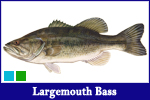 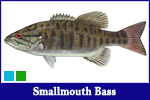
|
|
BOBBER FISHING RIG |
|---|
Also known as a float rig, is a basic fishing setup that uses a bobber (or float) to suspend bait at a desired depth and to visually indicate when a fish bites. It's a simple yet effective method, especially popular with beginners and for targeting fish in specific water depths.
See a larger Illustration of a minnow under a bobber setup.
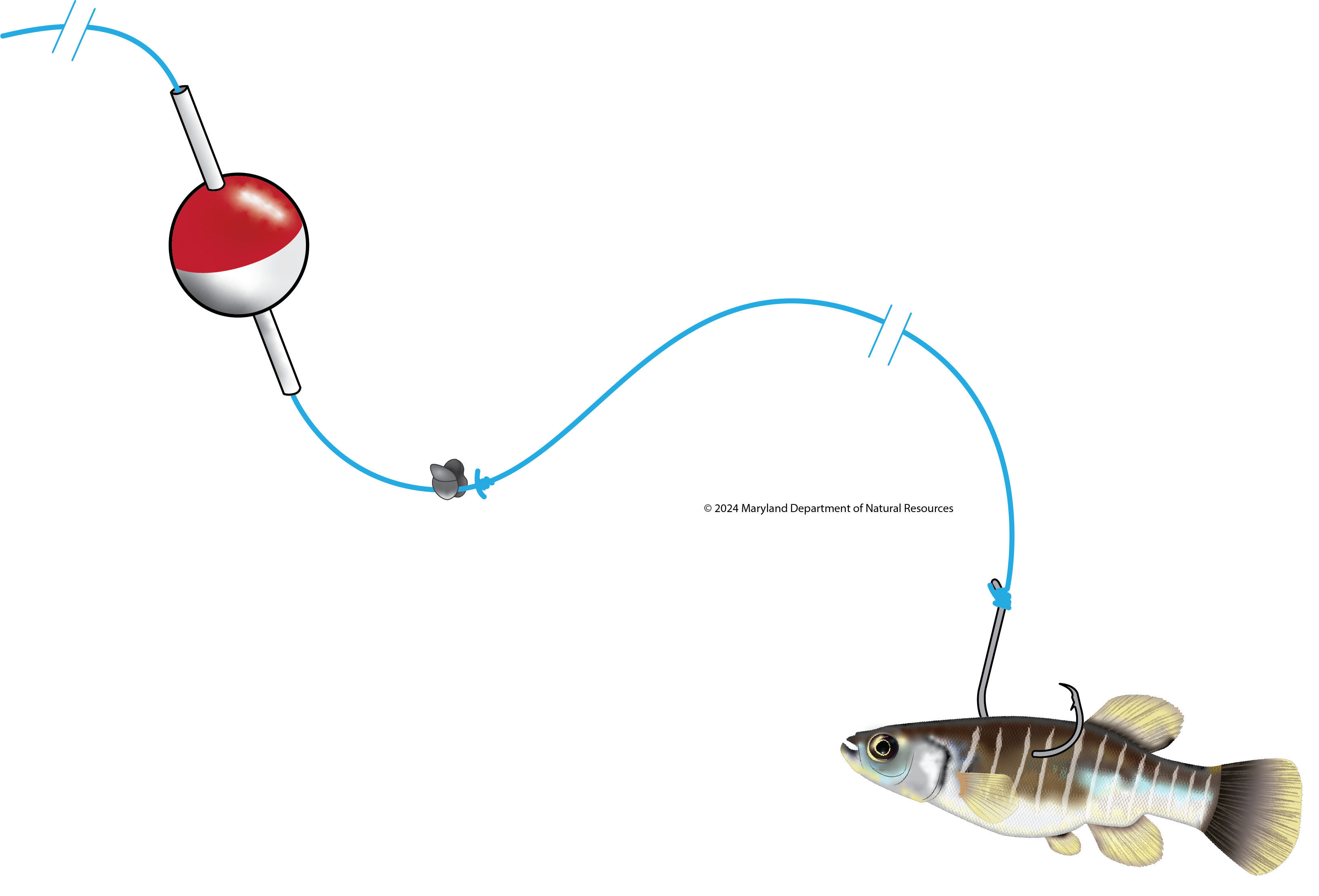
|
|
BUZZ BAIT |
|---|
These "safety pin" wire lures for surface fishing have a propeller blade on one wire and a weighted body, skirt and hook on the other.
See a larger Illustration of this lure.

|
|
CARAPACE |
|---|
carapace is the shell on back of the crab that is made of a hard bone called chitin.
|
|
CASTING SPOON |
|---|
A spoon-shaped metal or hard plastic lure that wobbles to attract fish. They can be fitted with a fixed (solid) hook or swinging hook, that has a single, double or treble points.See a larger Illustration of this lure.
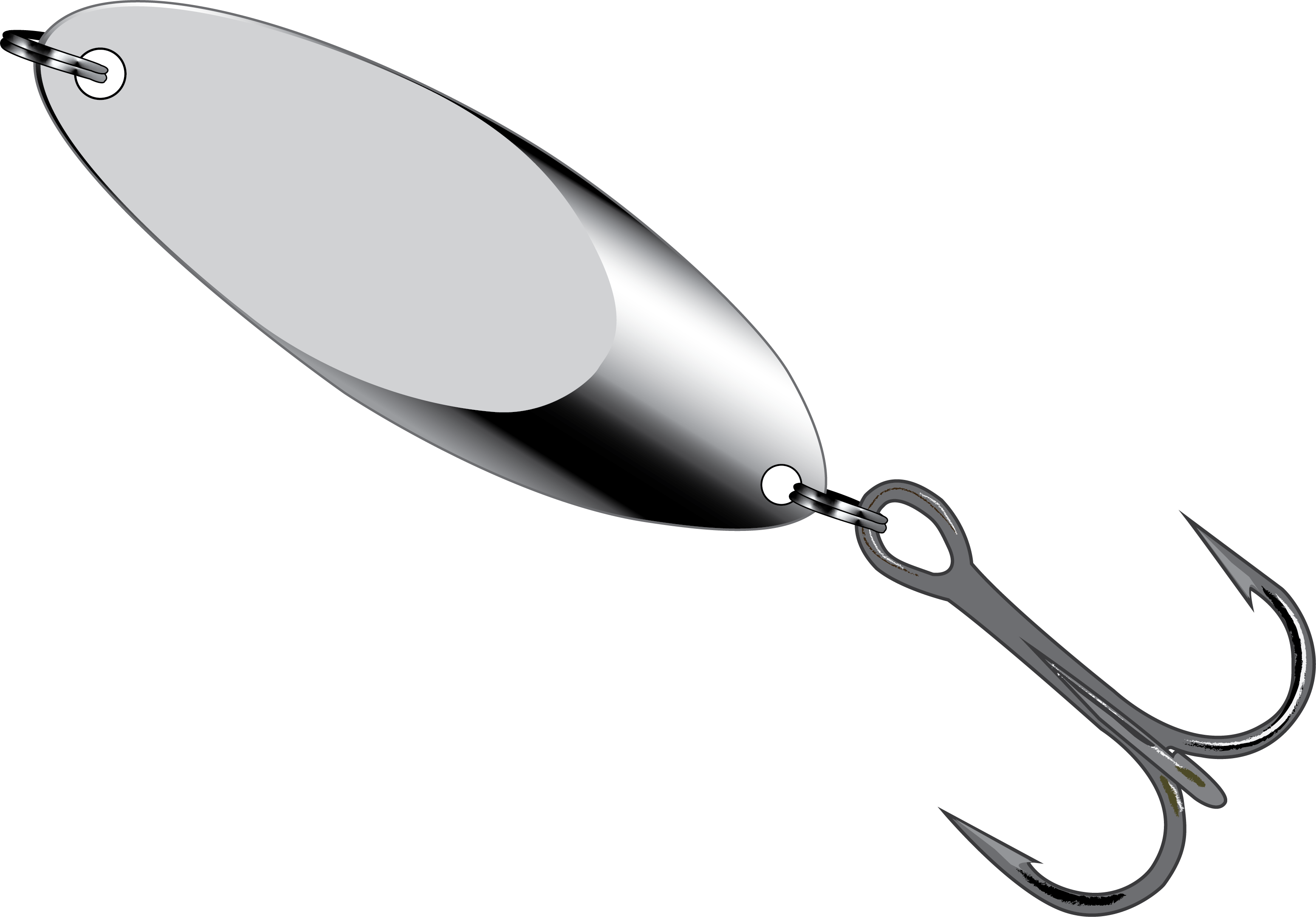
|
|
CATCH |
|---|
Catch means to take, kill, trap, gather, harvest or in any manner reduce any fish to personal possession.
|
|
CHATTERBAIT |
|---|
A bladed jig, known for its distinctive vibration and flash. It consists of a jig head with a blade attached to the front, which creates a strong vibration and side-to-side action when retrieved through the water. This unique action mimics a baitfish, attracting predatory fish like bass.
See a larger Illustration of a chatterbait.

|
|
CHUMMING |
|---|
A fishing technique by which bait or scent is released into the water to attract fish to take a lure or baited hook. Chum consists of live, dead, ground-up or prepared baits and scents and is used in fresh and saltwater.
|
|
CIRCLE HOOK |
|---|
A type of fish hook which is sharply curved back in a circular shape. It has become widely used among anglers in recent years because the hook generally catches more fish and is rarely swallowed.
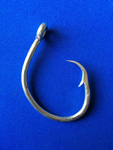
|
|
CLARKSPOON |
|---|
A type of metal fishing lure,
known for its diamond shape and built-in swivel system that creates a lot of flash and movement while reducing line twist. See a larger Illustration of a Clarkspoon.

|
|
CRANKBAIT |
|---|
A fish-like hard lure or plug designed to swim under the surface, often made of plastic or wood. Some are combined with replaceable soft plastic tails. See an Illustration of a lipped lure or a
lipless crankbait.
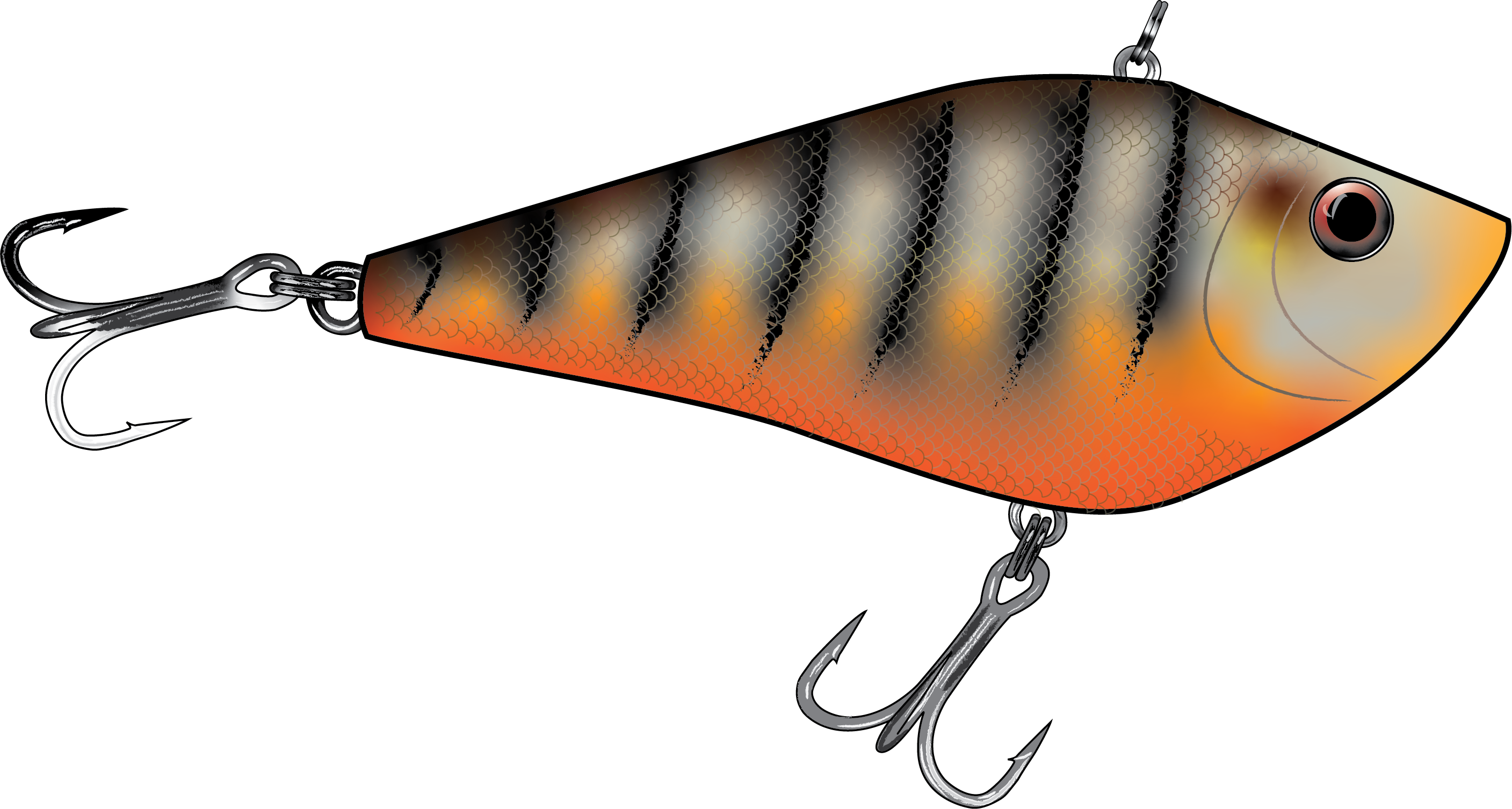 
|
|
CULL |
|---|
After being in possession of a fish, to discard or exchange that fish to possess another fish of the same species.
|
|
DAILY CREEL |
|---|
Daily creel is the number of fish that an angler can keep after a single day of fishing.
|
|
DRONE SPOON |
|---|
The drone spoon is the original artificial fishing lure. First marketed in 1922, this bait was designed and developed by a fisherman (especially) for fishermen. No other spoon displays quite the same erratic strike-bringing action of a drone.
See a larger Illustration of this lure.

|
|
EEZ |
|---|
The U.S. Exclusive Economic Zone is where the U.S. federal government has jurisdiction over natural resources it begins at 3 nautical miles and extends to 200 nautical miles from the Maryland coast.
|
|
FISH FINDER RIG |
|---|
A fishing rig designed to allow a bait to move naturally while the weight stays stationary on the bottom, often used for surf fishing or when targeting fish on the bottom. It's characterized by a weight that slides freely on the main line, typically attached to a swivel, with a leader and hook below it. This design allows the fish to pick up the bait without feeling the weight of the sinker, potentially resulting in a more natural presentation and better hooksets.
See a larger Illustration of this rig.

|
|
FLOAT |
|---|
Also called a "bobber", these suspend hooked bait off of the bottom, and signal hits by "bobbing" when a fish takes the bait. See a larger Illustration of different types of floats.

|
|
HIGH-LOW FISHING RIG |
|---|
Also known as a bottom rig or dropper loop rig, is a fishing setup used to present two hooks at different heights on the same line, typically for bottom fishing.
See a larger Illustration of this rig.
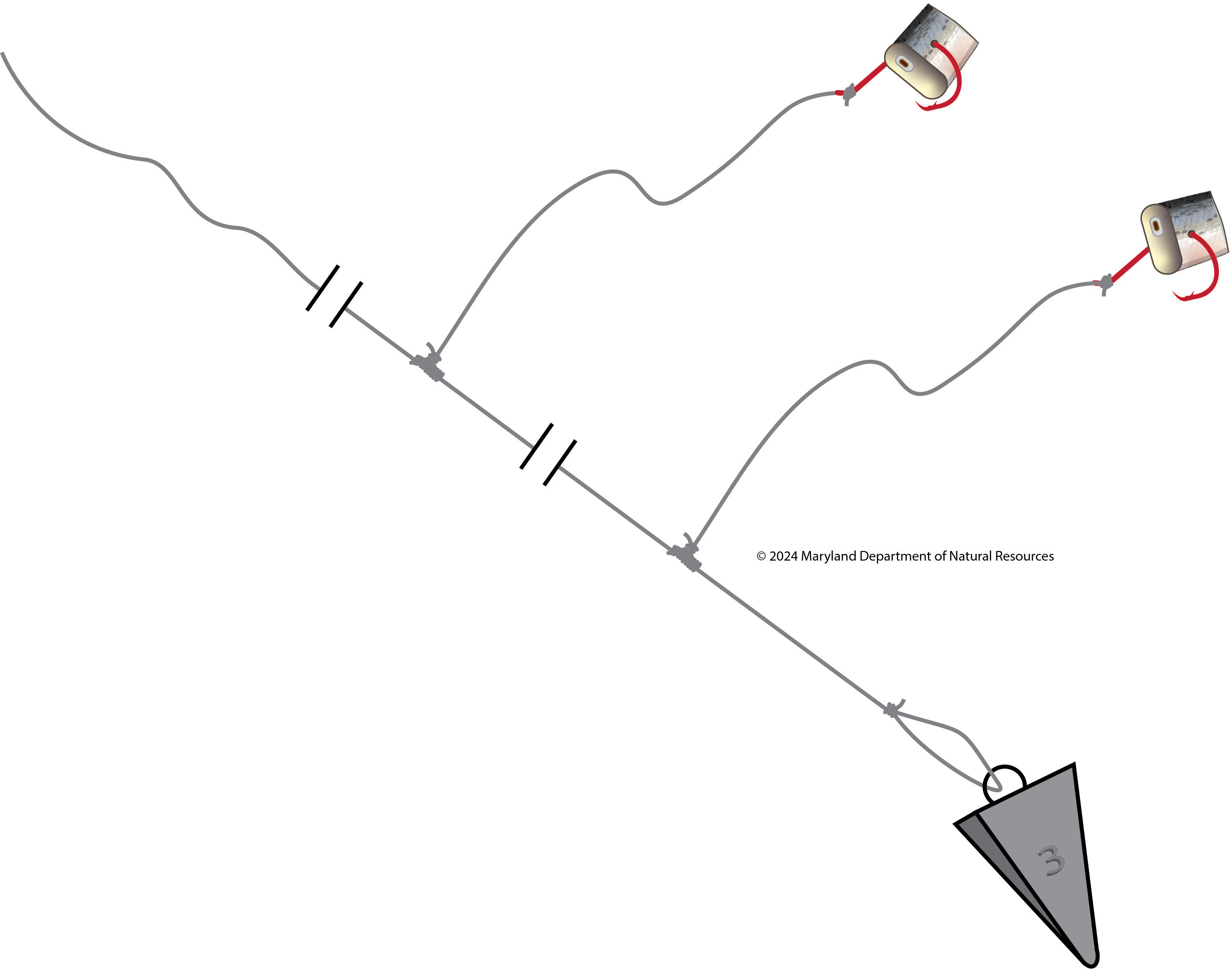
|
|
HOOK |
|---|
A metal wire device most commonly shaped like a "J" with an opening or "eye" at one end to which the line is tied and a point at the other end to catch the fish. Circle hooks have an angled point. Double and treble hooks have two or three points, respectively.
|
|
HOSE/TUBE |
|---|
A trolling lure made out of long sections of surgical tubing, used for striped bass and bluefish in the Chesapeake Bay, also known as "surgical hose" or "surge tubes".
See a larger illustration of this lure.
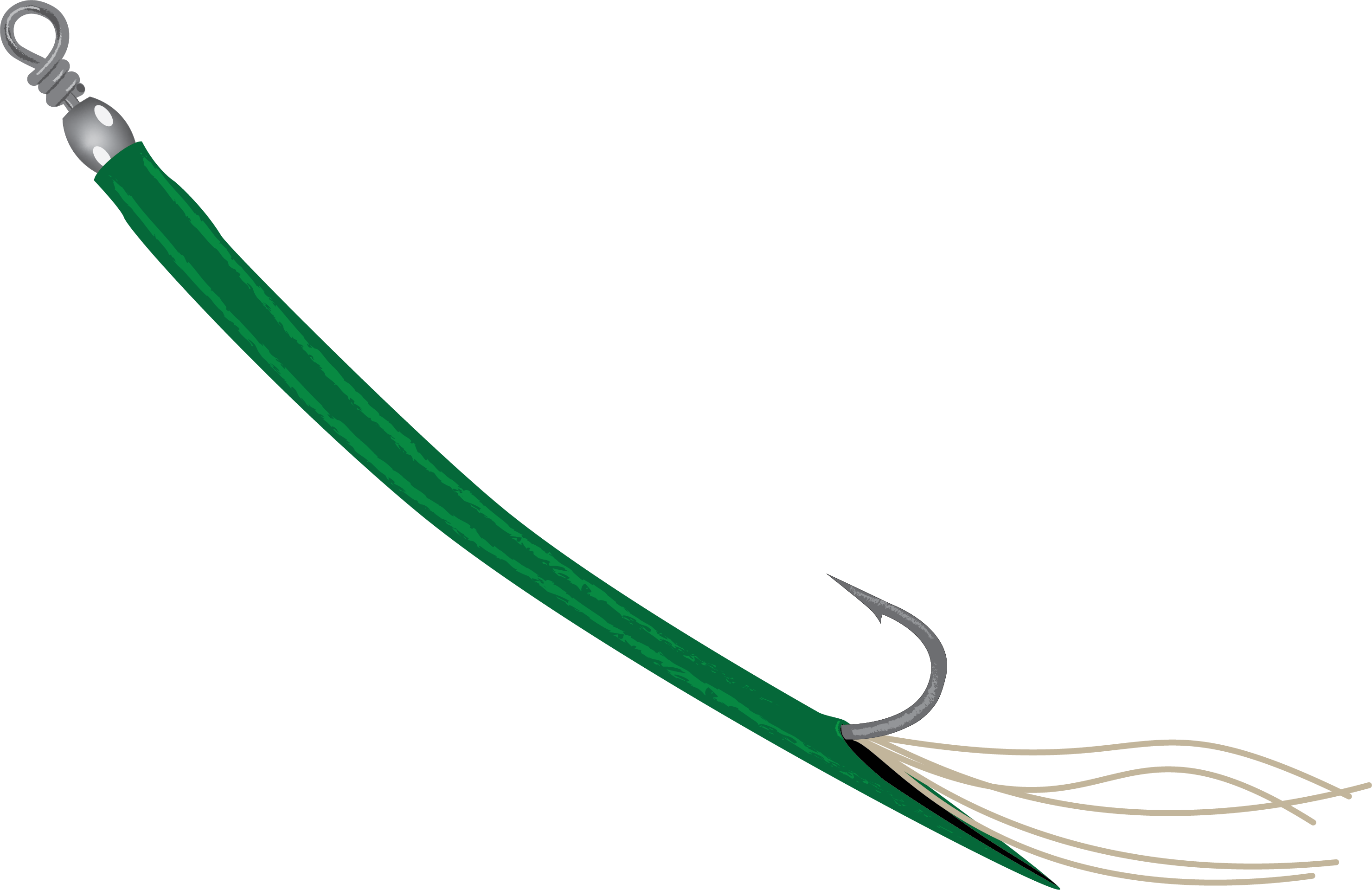
|
|
"IN AGGREGATE" |
|---|
A catch of related fish species counted together.
|
|
INVASIVE |
|---|
Invasive Fish (Chesapeake Channa (Northern Snakehead),
Blue Catfish,
Flathead Catfish) are not native to Maryland's ecosystem and have been known to cause significant economic or ecological harm, such as: Loss of biodiversity, Altered aquatic food webs, Reduced water quality, Reduced public safety and health, Decline in fisheries and habitat, Damage to infrastructure, and Loss of tourism and recreation.
Learn more about the invasive fisheries program.
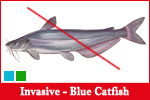 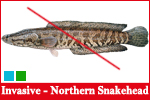 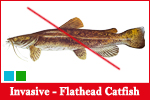
|
|
JERKBAIT LURE |
|---|
A type of fishing lure, typically a hard plastic or balsa wood bait, designed to mimic a wounded or fleeing baitfish. It's characterized by its long, slender body and the action imparted by the angler's rod jerks, which cause it to dart and wobble erratically through the water. Jerkbaits are known for their suspending action, meaning they can be paused in the water column and remain relatively stationary, mimicking a dying baitfish.
See a larger Illustration of this rig.

|
|
JIG |
|---|
Sometimes called
"bucktails", these weighted-body (often lead) lures are molded on special hooks and rigged with a hair tail or soft plastic skirt or worm.
See a larger illustration of a bucktail.

|
|
JIGGING |
|---|
A method of dropping a lure into the water over a fishing site and moving it - "jigging it" - up and down to attract fish. Done from a pier or boat.
|
|
LEADER |
|---|
A length of monofilament, wire or other stranded material tied between the end of the line and the lure or hook. Leaders provide extra strength or abrasion resistance from the rough mouth and teeth of fish (pike, barracuda, sharks), scales (sharks), gill covers (tarpon and snook), blows from tails (tuna).
|
|
LINE |
|---|
Specialized "string" used for fishing. Nylon monofilament line is the most popular. Other lines are made of different materials, including braided fibers and wire. FLY LINE is a specialized line made of a plastic coating on a core and often made tapered (changing diameter) to make fly casting easier. (To preserve good fishing, take any discarded line with you when you leave. Discarded line can snag and harm wildlife, and kill fish, turtles, frogs, birds and small mammals.)
|
|
LIVE LINING |
|---|
Using a live finfish on a hook for the purpose of catching other fish with hook and line, rod and reel, or handlines.
See a larger illustration of live lining a spot.

|
|
LUNKER |
|---|
Something large of its kind. This term is used especially when referring to large game fish.
|
|
LURE |
|---|
Any artificial item designed to attract fish and fitted with hooks. These include flies, hard plastic or wood lures (or plugs), soft plastic imitations, large offshore skirted baits,
metal spoons, lead-head lures (jigs), bladed lures, spinners, spinnerbaits.
|
|
MOLE CRAB (aka Sand Flea) |
|---|
The Atlantic mole crab (Emerita talpoida) is a small, sand-colored, egg-shaped crustacean found in the swash zone of the Atlantic coast, known for its ability to burrow backward into the sand with its feathery antennae exposed to filter-feed on plankton. Also called sand crabs or beach fleas, these harmless creatures have no claws and rely on their camouflage, quick burrowing, and filter-feeding for survival.
See a larger illustration of a Mole Crab (aka Sand Flea).

|
|
PADDLETAIL |
|---|
A fishing lure with a paddle-shaped tail made of soft plastic.
See a larger illustration of a paddletail rigged with a jighead.

|
|
POPPERS |
|---|
Popping plugs, or “poppers,” are saltwater fishing lures that splash across the surface, drawing a reaction bite from aggressive predators, and work best at dawn and dusk when fish are more likely to feed on the surface.
See a larger Illustration of this lure.

|
|
POSSESSION |
|---|
Any condition where a fish is controlled with the angler's intent of ownership. A possession limit is the maximum number of fish that an angler may have in their possession after two or more days of fishing.
|
|
REEL |
|---|
A mechanical device for holding and spooling fishing line. Reels have a line spool, brake to slow running fish, handle to retrieve line and foot for clamping to a rod. Reel styles include
CASTING (revolving spool),
SPINNING (line coiling off the stationary spool);
SPINCAST, (like spinning but with a nose cone), and FLY (storing thick fly line/backing and to fight big fish).
|
|
ROD |
|---|
A long lever, usually made of fiberglass, graphite or composite materials and used to catch fish. Different types are available, such as rods for spinning, fly fishing, spin-cast, bait casting, boat fishing offshore trolling, surf fishing, jetty/pier fishing, etc. Most rods have a reel-holding clamp and guides through which the line runs.
|
|
SANTEE COOPER RIG |
|---|
A type of fishing lure, typically a hard plastic or balsa wood bait, designed to mimic a wounded or fleeing baitfish. It's characterized by its long, slender body and the action imparted by the angler's rod jerks, which cause it to dart and wobble erratically through the water. Jerkbaits are known for their suspending action, meaning they can be paused in the water column and remain relatively stationary, mimicking a dying baitfish.
See a larger Illustration of this rig.
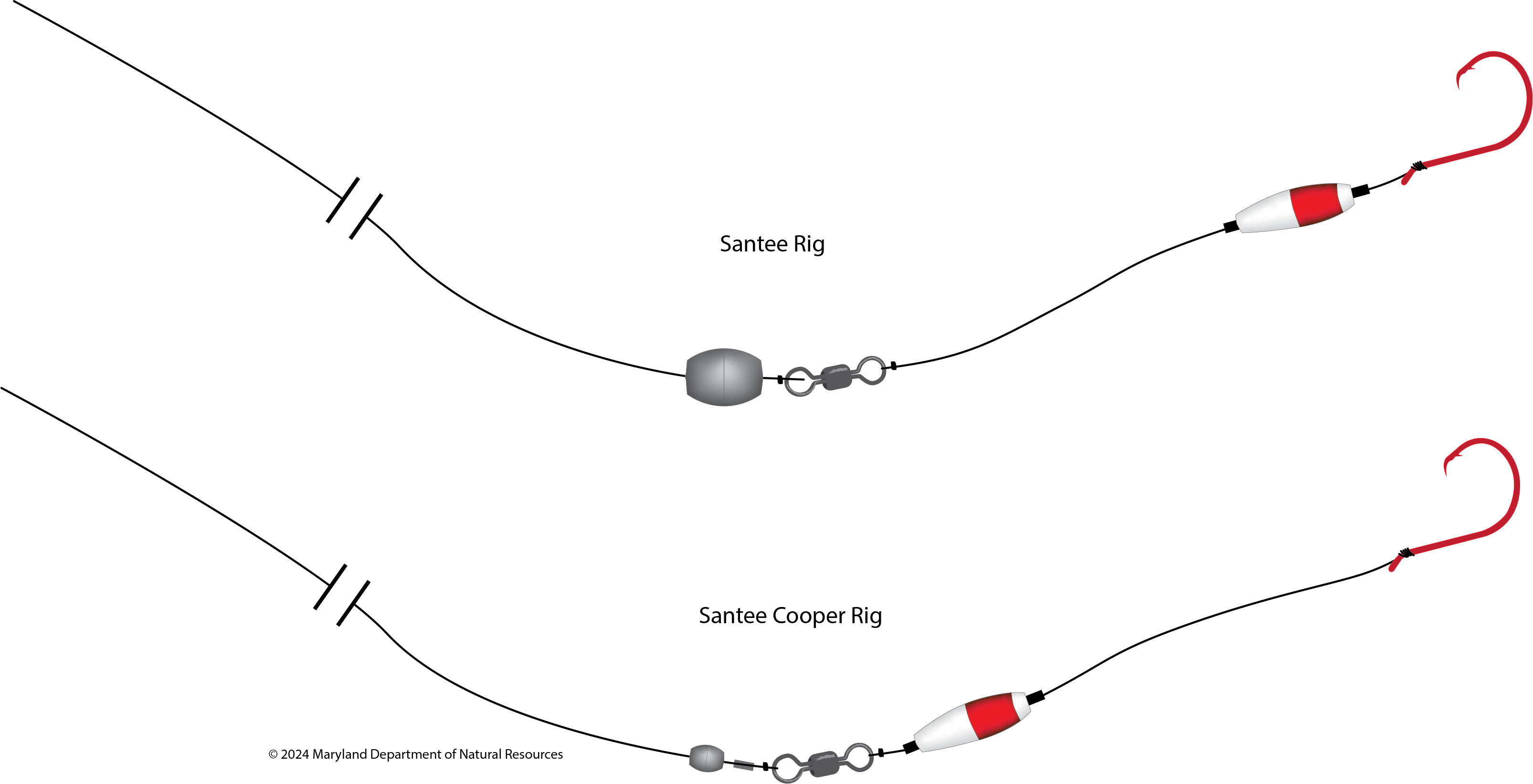
|
|
SEA NETTLE |
|---|
This jellyfish species can be identified by an opaque white bell and long, trailing tentacles that carry a painful sting for swimmers and waders alike.
|
|
SINKER |
|---|
A weight of lead or other metals designed to sink a hooked bait or lure. See a larger Illustration of this lure.

|
|
SNAP |
|---|
A small device similar to a dog leash snap, tied to the line and used for attachment and quick release of hooks, rigs and lures.
|
|
SOFT PLASTIC LURES |
|---|
Made of soft plastic to resemble a worm, lizard, crayfish, shrimp or generic wiggling creature. Often sold in bulk to be rigged on
hooks by the angler. See a larger illustration of a soft plastic swim shad.
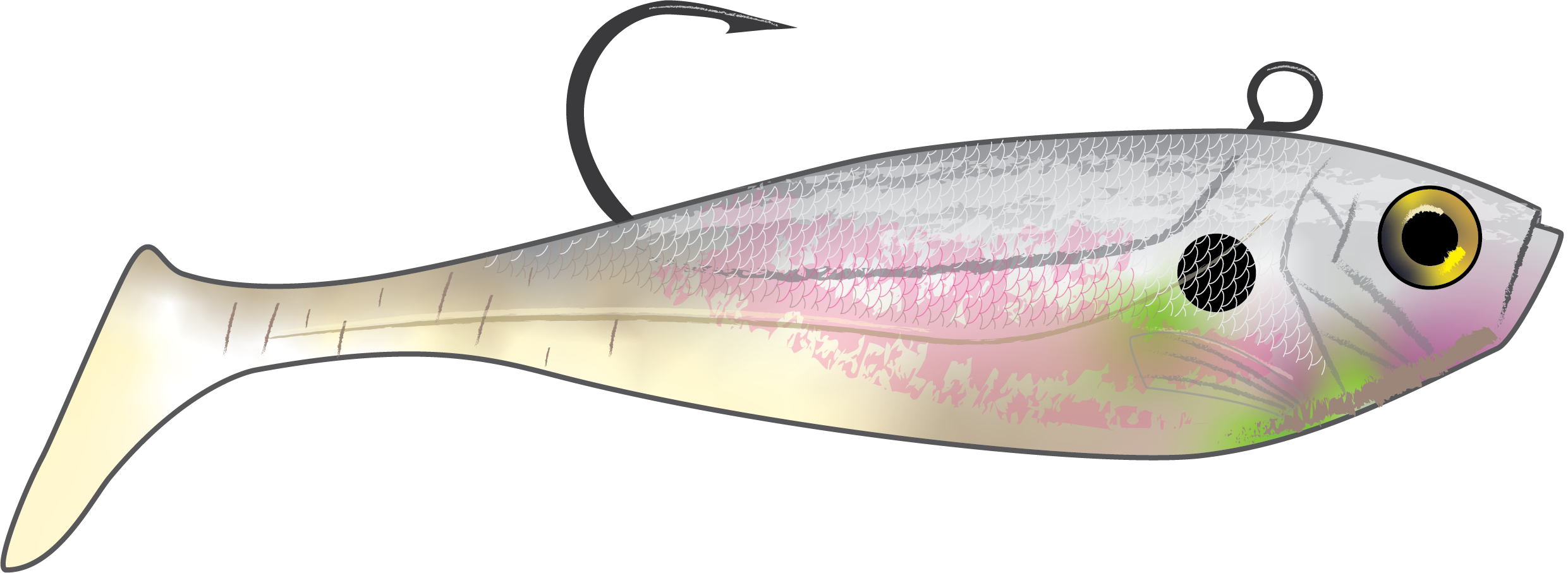
|
|
SPIN JIG |
|---|
A spin jig combines the action of a jig with the flash and vibration of a spinnerbait. It typically features a jig head with a blade attached to it, which spins and creates a visual and auditory attractant for fish.
See a larger Illustration of this lure.

|
|
SPINNER |
|---|
Spinner blades rotate around the straight wire shaft of these weighted-body treble-hook lures.
See a larger Illustration of this lure.

|
|
SPINNER BAIT |
|---|
"Safety pin" style wire
lures with one or more spinner blades on the end of one wire, and a weighted body, skirt and hook on the other. Used to fish around structure such as trees and stumps. See an Illustration of this lure.

|
|
SPOOK LURE |
|---|
Also known as a "walking bait," is a type of topwater fishing lure characterized by its slender, elongated body and ability to create a "walk-the-dog" swimming action. This action is achieved by a rhythmic, slack-line retrieve that makes the lure zigzag back and forth on the surface of the water. The Heddon Zara Spook is a well-known example of a spook lure.
See a larger Illustration of this lure.

|
|
SPOON |
|---|
a type of fishing lure that is typically made of metal and has a flat, oval shape with a concave surface. It is designed to imitate the movement of injured baitfish, triggering the predatory instincts of fish. Spoons are known for their simple design, which creates a wobble and flash as it moves through the water. See a larger Illustration of this lure.

|
|
STILL FISHING |
|---|
Fishing without moving the bait once it is cast with replaceable soft plastic tails.
|
|
STINGER HOOK |
|---|
A hook that trails another hook or hook unit, either by direct physical attachment to the lead hook or hook unit, or by a connective device such as a line, swivel or chain, and is part of the same bait or lure. Review all regulations before using this rig in Maryland (https://dsd.maryland.gov/regulations/Pages/08.02.25.03.aspx).
|
|
STRIKE |
|---|
Any "hit" by a fish taking a lure or bait.
|
|
STREAMERS (Fly Fishing) |
|---|
a wet fly that imitates a small baitfish that larger fish feed on. There are many streamer baitfish imitations that will catch fish in lakes, streams, ponds and in saltwater. One of which is the
Wooly Bugger.
|
|
STRUCTURE SPOON |
|---|
Both casting and vertical jigging techniques are used for fishing these swinging hook-heavy metal lures.
|
|
SWIVEL |
|---|
A small device with two or more eyes (rings) a central swiveling part. They are used between a lure or leader and line to prevent line twist. Otherwise, line twist can occur when a revolving lure twists line to cause tangles. See a larger Illustration of this lure.

|
|
TACKLE BOX |
|---|
A box or bag with special compartments and features to hold terminal tackle, lures, hooks, and other fishing gear.
|
|
TERMINAL TACKLE |
|---|
A general term for describing bobbers, sinkers, hooks, rigs, snaps, swivels and other gear used at the end of a line.
|
|
TOPWATER LURE |
|---|
Lures made of hard plastic, wood, hollow rubber/plastic and designed to float on the surface to attract fish when twitched or moved.
See a larger Illustration of a topwater frog.

|
|
TREBLE HOOK |
|---|
A fishhook where three hooks share a single shank, each point separated by 120º.
|
|
TROLLING |
|---|
A method of slowly running a boat while trailing lures or bait. This fishing method is used to cover a lot of water and to find fish.
|
|
TROLLING SPOON |
|---|
A large
spoon that is trailed, or trolled, behind a boat to catch fish.
See a larger Illustration of this lure.

|
|
TUBE BAIT |
|---|
Made of soft plastic, these tubular lures are fished with special weighted
hooks inserted into the hollow body. See a larger illustration of this lure.

|
|
UMBRELLA RIG |
|---|
A fishing lure that uses a wire frame to hold multiple artificial baits, designed to mimic a school of baitfish. It is a type of multi-lure system that is cast and retrieved, and is also known as an "A-rig". Umbrella rigs that have no more than two hooks or two sets of hooks are legal in MD.
See a larger illustration of this rig.

|
|
WACKY RIG |
|---|
Hooking a soft plastic bait, typically a stickbait like a soft plastic worm, through the middle.
See a larger illustration of three different rigs.

|
|
WEEDLESS SPOON |
|---|
Wobbling spoons made with a fixed
hook and guard for fishing weeds.
See a larger illustration of this lure.

|
|
WHOPPER PLOPPER LURE |
|---|
a type of hard plastic topwater fishing lure known for its distinctive "plop, plop, plop" sound and bubble trail created by a rotating propeller on the rear of the lure. It's designed to attract predatory fish, particularly bass, with its unique action and sound. The lure is effective at various speeds and in different conditions, making it a versatile tool for anglers.
See a larger Illustration of this lure.

|